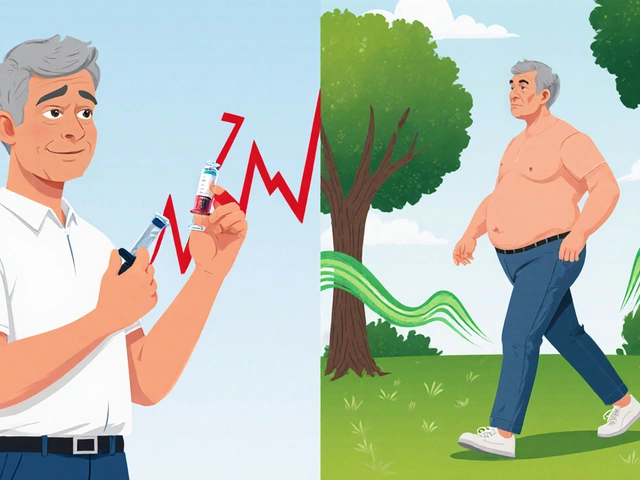Diabetes Medication Cost Calculator
Medication Selection
Cost Comparison
Calculating...
When you hear people talk about the "go‑to" drug for diabetes, the name that pops up almost every time is Metformin. It isn’t a coincidence - this old‑school, inexpensive pill still dominates prescriptions worldwide, even after more than six decades on the market.
What makes a medication "most popular"?
Popularity isn’t just about sales numbers. It’s a mix of prescription volume, safety profile, cost, and how well a drug fits into everyday life. To understand why Metformin tops the chart, we first need to know the landscape of diabetes treatment.
Quick Snapshot of Diabetes Medication Classes
Diabetes drugs fall into several families, each targeting a different part of the glucose‑control puzzle. Below is a high‑level look at the five most common groups.
| Class | Mechanism | Typical Dosage | Average US Cost (monthly) | Weight Effect | Cardiovascular Benefit |
|---|---|---|---|---|---|
| Biguanides (Metformin) | Decreases hepatic glucose production, improves insulin sensitivity | 500‑2000mg/day | $4‑$12 | Neutral or modest loss | Reduces cardiovascular events in overweight patients |
| Sulfonylureas | Stimulates pancreatic beta‑cells to release insulin | 2.5‑10mg/day | $15‑$30 | Weight gain | No clear benefit |
| GLP‑1 Receptor Agonists | Mimics incretin hormone, boosts insulin, slows gastric emptying | 0.6‑1.8mg weekly (injectable) or daily oral | $800‑$1200 | Weight loss | Significant CV risk reduction |
| SGLT2 Inhibitors | Blocks kidney re‑absorption of glucose, promotes excretion | 5‑10mg/day | $500‑$800 | Weight loss | Heart failure & renal protection |
| Insulin (basal & rapid‑acting) | Directly replaces deficient hormone | Varies by individual | $30‑$150 | Neutral | Essential for type 1 & advanced type 2 |
Meet the Champion: Metformin
Metformin is a biguanide oral medication that lowers blood glucose primarily by reducing liver glucose output and enhancing peripheral insulin sensitivity. It was first approved in the United States in 1995 and quickly became the first‑line therapy for type 2 diabetes.
- Prescribed to roughly 150million people worldwide (WHO estimate 2024).
- Cost per month often under $10 in generic form, making it the most affordable option.
- Low risk of hypoglycemia when used alone.
- Potential modest weight loss, which helps many patients stay motivated.
- Extensive safety data: decades of real‑world use with a well‑characterized side‑effect profile.
Because of these factors, most national guidelines - from the American Diabetes Association (ADA) to the World Health Organization (WHO) - place Metformin at the top of the treatment ladder.
Why Some Patients Can't Take Metformin
Even a superstar drug has its limits. Common reasons for intolerance include gastrointestinal upset (nausea, diarrhea) and, rarely, a serious condition called lactic acidosis. About 5‑10% of patients discontinue within the first few months.
Doctors often mitigate side effects by starting at a low dose (e.g., 500mg once daily) and using the extended‑release formulation, which reduces stomach irritation.
Alternatives When Metformin Isn’t Enough
If blood sugar remains above target despite the maximum tolerated Metformin dose, physicians consider add‑on therapies. The choice depends on factors like cardiovascular risk, kidney function, weight goals, and cost.
- Sulfonylureas are cheap but can cause hypoglycemia and weight gain.
- GLP‑1 receptor agonists (e.g., semaglutide) deliver strong glucose reduction and weight loss but are pricey and injectable.
- SGLT2 inhibitors (e.g., empagliflozin) protect the heart and kidneys, yet they increase risk of urinary tract infections.
- For patients with advanced disease, insulin remains the most reliable way to achieve tight control.
Prescription Trends: Numbers that Tell a Story
Data from the IQVIA National Prescription Audit (2023) show Metformin accounting for 31% of all diabetes prescriptions in the United States, far ahead of the next best - sulfonylureas at 12%.
Globally, a 2024 WHO report notes that in low‑ and middle‑income countries, Metformin captures over 45% of the diabetes drug market, largely because of its low price and inclusion on national essential‑medicine lists.
Safety & Monitoring: What Patients Should Know
Before starting Metformin, doctors check kidney function (eGFR). The drug is contraindicated if eGFR falls below 30mL/min/1.73m². Routine labs every 3‑6 months help catch any emerging issues.
Common side effects - mild stomach upset - often fade within a few weeks. If they persist, patients can switch to the extended‑release form or a different class altogether.

Future Outlook: Will Metformin Stay on Top?
Newer agents keep pushing the envelope on cardiovascular and renal benefits. However, none have combined Metformin’s affordability, decades‑long safety record, and ease of use.
Research is exploring Metformin for non‑diabetic uses - like aging, cancer prevention, and polycystic ovary syndrome - which may further cement its status as a versatile drug.
Key Takeaways
- Metformin remains the most prescribed diabetes medication worldwide due to cost, safety, and efficacy.
- Guidelines from major health bodies place it as first‑line therapy for type 2 diabetes.
- Side effects are usually mild; extended‑release versions improve tolerability.
- When Metformin alone isn’t enough, clinicians add sulfonylureas, GLP‑1RAs, SGLT2 inhibitors, or insulin based on individual risk profiles.
- Its dominance is likely to continue, even as newer, more expensive drugs enter the market.
Frequently Asked Questions
Why is Metformin considered the first‑line drug for type 2 diabetes?
Because it lowers blood sugar effectively, has a low risk of causing hypoglycemia, is inexpensive, and has been proven safe over decades of use. Major guidelines (ADA, WHO) thus recommend it before any newer agents.
Can Metformin cause weight loss?
Yes, modest weight loss (1‑3kg) is common, especially when combined with lifestyle changes. The effect is milder than that of GLP‑1 agonists but still helps many patients stay motivated.
Is Metformin safe for people with kidney disease?
Metformin is safe if kidney function is adequate (eGFR ≥45mL/min). Below that, dosage must be reduced, and it is contraindicated under eGFR 30mL/min. Regular monitoring is essential.
What should I do if I experience stomach upset on Metformin?
Start with a low dose, take the tablet with meals, and consider the extended‑release formulation. If symptoms persist after two weeks, talk to your doctor about switching classes.
How does Metformin compare cost‑wise to newer drugs like GLP‑1 agonists?
A generic Metformin tablet costs under $12 per month, whereas GLP‑1 agonists can exceed $800 monthly. The price gap makes Metformin the go‑to choice for most patients, especially in low‑income settings.






